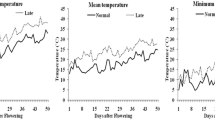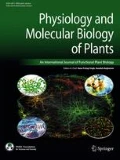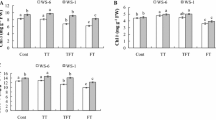Abstract
Chickpea being a winter season crop often experiences heat stress during reproductive phase. For chickpea production, terminal heat stress is one of the major constraints. Plants have built up numerous mechanisms to combat the heat stress. We considered the photosynthetic pigments for heat tolerance. Therefore, in order to investigate the heat tolerance in relation to photosynthetic pigments, a field trial was carried out having 4 contrasting genotypes namely BG 240 and JG 14 (relatively heat tolerant), SBD 377 (moderately tolerant) and ICC 1882 (relatively heat sensitive). Heat stress was imposed by altering the sowing date i.e. normal (18th November) and late sown (18th December). Under delayed sown condition, heat stress was faced by crop starting from flowering stage to crop maturity. Under heat stress condition, heat tolerant genotypes BG 240 and JG 14 maintained higher level of membrane stability, RWC (%), osmolytes, dry matter partitioning, grain yield, heat tolerance index and had higher values of zeaxanthin, quantum yield of PS II (Fv/Fm ratio), non-photochemical quenching (NPQ), photosynthetic rate, level of photosynthetic pigments (chlorophylls and carotenoids) and lower level of violaxanthin, and lipid peroxidation as compared to heat sensitive one (ICC 1882). In addition to this, Fv/Fm ratio and NPQ exhibited positive relationship with heat tolerance which suggested the involvement of xanthophyll cycle pigments in chickpea heat tolerance.












Similar content being viewed by others

References
Arnon DI (1949) Copper enzyme polyphenoloxides in isolated chloroplast in Beta vulgaris. Plant Physiol 24:1–15
Ashraf M, Hafeez M (2004) Thermotolerance of pearl millet and maize at early growth stages: growth and nutrient relations. Biol Plant 48:81–86
Blum A, Ebercon A (1981) Cell membrane stability as a measure of drought and heat tolerance in wheat. Crop Sci 21:43–47
Blum A, Klueva N, Nguyen HT (2001) Wheat cellular thermotolerance is related to yield under heat stress. Euphytica 117:117–123
Bouslama M, Schapaugh WT (1984) Stress tolerance in soybean. Part 1: evaluation of three screening techniques for heat and drought tolerance. Crop Sci 24:933–937
Camejo D, Rodríguez P, Morales MA, Dell’Amico JM, Torrecillas A, Alarcón JJ (2005) High temperature effects on photosynthetic activity of two tomato cultivars with different heat susceptibility. J Plant Physiol 162:281–289
Chen THH, Shen ZY, Lee PH (1982) Adaptability of crop plants to high temperature stress. Crop Sci 22:719–725
Craufurd PQ, Prasad PV, Summerfield RJ (2002) Dry matter production and rate of change of harvest index at high temperature in peanut. Crop Sci 42:46–151
De Silva HCC, Asaeda T (2017) Effects of heat stress on growth, photosynthetic pigments, oxidative damage and competitive capacity of three submerged macrophytes. J Plant Interact 12(1):228–236. https://doi.org/10.1080/17429145.2017.1322153
Demmig-Adams B, Adams WW III (1996) The role of xanthophyll cycle carotenoids in the protection of photosynthesis. Trends Plant Sci 1(1):21–26
Devasirvatham V, Gaur PM, Mallikarjuna N, Tokachichu RN, Trethowan RM, Tan DKY (2012a) Effect of high temperature on the reproductive development of chickpea genotypes under controlled environments. Funct Plant Biol 39:1009–1018. https://doi.org/10.1071/FP12033
Devasirvatham V, Tan DKY, Gaur PM, Raju TN, Trethowan RM (2012b) High temperature tolerance in chickpea and its implications for plant improvement. Crop Pasture Sci 63:419–428. https://doi.org/10.1071/CP11218
Dixit GP, Srivastava AK, Singh NP (2019) Marching towards self-sufficiency in chickpea. Curr Sci 216(2):239–242
Efeoglu B, Terzioglu S (2009) Photosynthetic responses of two wheat varieties to high temperature. Eur Asia J Biol Sci 3:97–106
Esteban R, Moran JF, Becerril JM, García-Plazaola JI (2015) Versatility of carotenoids: an integrated view on diversity, evolution, functional roles and environmental interactions. Environ Exp Bot 119:63–75. https://doi.org/10.1016/j.envexpbot.2015.04.009
Havaux M, Greppin H, Strasser RJ (1991) Functioning of photosystems I and II in pea leaves exposed to heat stress in the presence or absence of light: Analysis using in vivo fluorescence absorbance, oxygen and photoacoustic measurement. Planta 186(1):88–98
Havaux M (1998) Carotenoids as membrane stabilizers in chloroplasts. Trends Plant Sci 3:147–151
Heath RL, Packer L (1968) Photoperoxidation in isolated chloroplasts, kinetics and stoichiometry of fatty acid peroxidation. Arch Biochem Biophys 125:189–198
Hemantaranjan A, Nishant Bhanu A, Singh MN, Yadav DK, Patel PK, Singh R, Katiyar D (2014) Heat stress responses and thermotolerance. Adv Plants Agric Res 1(3):00012. https://doi.org/10.15406/apar.2014.01.00012
Hiscox JD, Israelstam GF (1979) A method for the extraction of chlorophyll from leaf tissue without maceration. Can J Bot 57:1332–1334
Jahns P, Latowski D, Strzalka K (2009) Mechanism and regulation of the violaxanthin cycle: the role of antenna proteins and membrane lipids. Biochim Biophys Acta 1787:3–14
Kalra N, Chakraborty D, Sharma A, Rai HK, Jolly M, Chander S, Kumar PR, Bhadraray S, Barman D, Mittal RB, Lal M, Sehgal M (2008) Effect of temperature on yield of some winter crops in northwest India. Curr Sci 94:82–88
Kaushal N, Gupta K, Bhandhari K, Kumar S, Thakur P, Nayyar H (2011) Proline induces heat tolerance in chickpea (Cicer arietinum L.) plants by protecting vital enzymes of carbon and antioxidative metabolism. Plant Physiol Mol Biol 17:203–213. https://doi.org/10.1007/s12298-011-0078-2
Kaushal N, Awasthi R, Gupta K, Gaur PM, Siddique KHM, Nayyar H (2013) Heat-stress-induced reproductive failures in chickpea (Cicer arietinum) are associated with impaired sucrose metabolism in leaves and anthers. Funct Plant Biol 40:1334–1349. https://doi.org/10.1071/FP13082
Khan NA, Khan S, Naz N, Shah M, Irfanullah A, Sher H, Khan A (2017) Effect of heat stress on growth, physiological and biochemical activities of wheat (Triticum aestivum L.). Int J Biol Sci 11(4):173–183
Kumar M, Sharma RK, Kumar P, Singh GP, Sharma JB, Gajghate R (2013) Evaluation of bread wheat (Triticum aestivum L.) genotypes for terminal heat tolerance through physiological traits and grain yield. Indian J Genet Plant Breed 73(4):446–449
Kumar P, Shah D, Singh MP (2017) Evaluation of chickpea (Cicer arietinum L.) genotypes for heat tolerance: a physiological assessment. Indian J Plant Physiol 22(2):164–177. https://doi.org/10.1007/s40502-017-0301-4
Lamaoui M, Jemo M, Datla R, Bekkaoui F (2018) Heat and drought stresses in crops and approaches for their mitigation. Front Chem 6:26. https://doi.org/10.3389/fchem.2018.00026
Lichtenthaler HK, Welburn AR (1983) Determination of total carotenoids and chlorophylls a and b of leaf extracts in different solvents. Biochem Soc Trans 11:591–592
Liu L, Shao Z, Zhang M, Wang Q (2015) Regulation of carotenoid metabolism in tomato. Mol Plant 8:28–39
Mahan JR, Mauget SV (2005) Antioxidant metabolism in cotton seedlings exposed to temperature stress in the field. Crop Sci 45:2337–2345
Martineau JR, Specht JE, Williams JH, Sullivan CY (1979) Temperature tolerance in soybean. I. Evaluation of technique for assessing cellular membrane thermostability. Crop Sci 19:75–78
Mendham NJ, Salisbury PA (1995) Physiology, crop development, growth and yield. In: Kimber DS, McGregor DI (eds) Brassica oilseeds: production and utilization. CABI, London, pp 11–64
Morita S, Yonermaru J, Takahashi J (2005) Grain growth and endosperm cell size under high night temperature in rice (Oryza sativa L.). Ann Bot 95:695–701
Pocock T, Krol M, Huner NPA (2004) The determination and quantification of photosynthetic pigments by reverse phase high-performance liquid chromatography, thin-layer chromatography, and spectrophotometry. In: Carpentier R (ed) Methods in molecular biology. Photosynthesis research protocols, vol 274. Humana Press Inc., Totowa, NJ, pp 137–148
Porch TG (2006) Application of stress indices for heat tolerance screening of common bean. J Agron Crop Sci 192:390–394
Rainey KM, Griffiths PD (2005) Inheritance of heat tolerance during reproductive development in snap bean (Phaseolus vulgaris L.). J Am Soc Hortic Sci 130(5):700–706
Sharma P, Jha AB, Dubey RS, Pessarakli M (2012) Reactive oxygen species, oxidative damage, and antioxidative defense mechanism in plants under stressful conditions. J Bot 2012:1–26. https://doi.org/10.1155/2012/217037
Srinivasan A, Takeda H, Senboku T (1996) Heat tolerance in food legumes as evaluated by cell membrane thermostability and chlorophyll fluorescence techniques. Euphytica 88:35–45
Trojak M, Skowron E (2017) Improvement of plant heat tolerance by modification of xanthophyll cycle activity. World Sci News 70(2):51–70
Tsukaguchi T, Kawamitsu Y, Takeda H, Suzuki K, Egawa Y (2003) Water status of flower buds and leaves as affected by high temperature in heat tolerant and heat-sensitive cultivars of snap bean (Phaseolus vulgaris L.). Plant Prod Sci 6:4–27
Van Hasselt PR, Strikwerda JT (1976) Pigment degradation in discs of the thermophilic Cucumis sativus as affected by light, temperature, sugar application and inhibitors. Plant Physiol 37(4):253–257
Vara Prasad PV, Craufurd PQ, Summerfield RJ, Wheeler TR (1999) Effects of short episodes of heat stress on flower production and fruit-set of groundnut (Arachis hypogaea L.). J Exp Bot 51(345):777–784
Wahid A (2007) Physiological implications of metabolites biosynthesis in net assimilation and heat stress tolerance of sugarcane sprouts. J Plant Res 120:219–228
Wahid A, Close TJ (2007) Expression of dehydrins under heat stress and their relationship with water relations of sugarcane leaves. Biol Plant 51:104–109
Wahid A, Ghazanfar A (2006) Possible involvement of some secondary metabolites in salt tolerance of sugarcane. J Plant Physiol 163:723–730
Wahid A, Shabbir A (2005) Induction of heat stress tolerance in barley seedlings by pre-sowing seed treatment with glycinebetaine. Plant Growth Reg 46:133–141
Wahid A, Gelani S, Ashraf M, Foolad MR (2007) Heat tolerance in plants: an overview. Environ Exp Bot 61:199–223
Wang J, Gan YT, Clarke F, McDonald CL (2006) Response of chickpea yield to high temperature stress during reproductive development. Crop Sci 46:2171–2178
Weatherly PE (1950) Studies in the water relations of cotton. 1. The field measurement of water deficits in leaves. New Phytol 49:81–97
Williams PC, Singh U (1987) Nutritional quality and the evaluation of quality in breeding program. Chickpea CAB International, Wallingford, pp 329–356
Wise RR, Olson AJ, Schrader SM, Sharkey TD (2004) Electron transport is the functional limitation of photosynthesis in field-grown Pima cotton plants at high temperature. Plant Cell Environ 27:717–724
Xiong X, Wang X, Liao MA (2012) Xanthophyll cycle and its relative enzymes. J Life Sci 6(9):980
Xu Q, Paulsen AQ, Guikema JA, Paulsen GM (1995) Functional and ultrastructural injury to photosynthesis in wheat by high temperature during maturation. Environ Exp Bot 35:43–54
Yamada M, Hidaka T, Fukamachi H (1996) Heat tolerance in leaves of tropical fruit crops as measured by chlorophyll fluorescence. Sci Hortic 67:39–48
Young LW, Wilen RW, Bonham-Smith PC (2004) High temperature stress of Brassica napus during flowering reduces micro-and megagametophyte fertility, induces fruit abortion, and disrupts seed production. J Exp Bot 55:485–495. https://doi.org/10.1093/jxb/erh038
Acknowledgements
The authors thank the IARI, New Delhi for providing necessary facility and Council of Scientific and Industrial Research, New Delhi for financial support (CSIR Project No.: 38(1335)/12/EMR).
Author information
Authors and Affiliations
Corresponding author
Additional information
Publisher's Note
Springer Nature remains neutral with regard to jurisdictional claims in published maps and institutional affiliations.
Rights and permissions
About this article
Cite this article
Kumar, P., Yadav, S. & Singh, M.P. Possible involvement of xanthophyll cycle pigments in heat tolerance of chickpea (Cicer arietinum L.). Physiol Mol Biol Plants 26, 1773–1785 (2020). https://doi.org/10.1007/s12298-020-00870-7
Received:
Revised:
Accepted:
Published:
Issue Date:
DOI: https://doi.org/10.1007/s12298-020-00870-7



